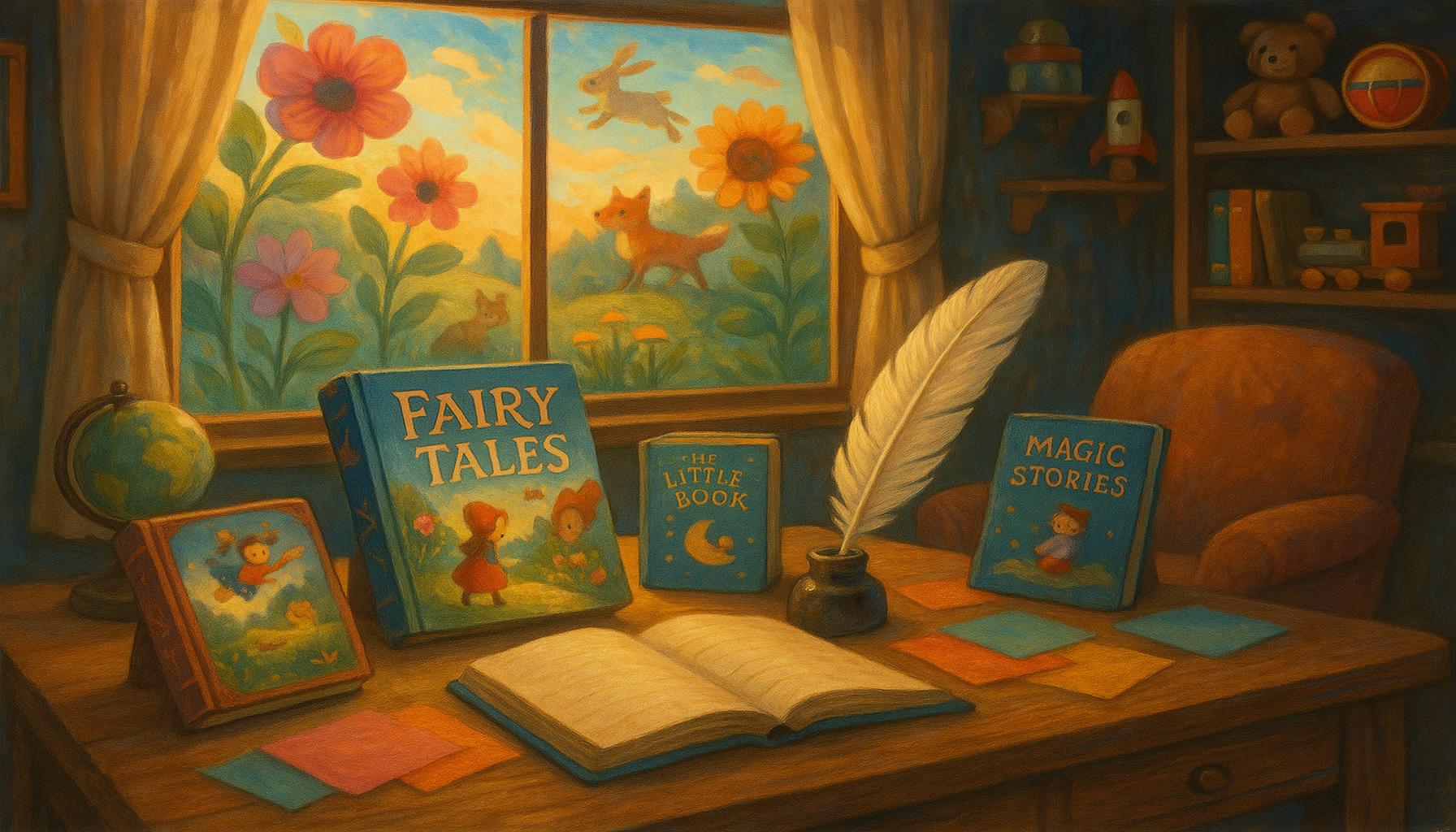Writing for Children: The Magic of Creating Imaginary Worlds for the Little Ones

The Wonders of Children’s Literature
There is a unique magic found in the pages of children’s literature. When authors weave tales for young readers, they enchant their minds with boundless possibilities. These stories not only entertain but transport kids to worlds where anything can happen, encouraging them to reach for the stars and dream beyond the ordinary.
The Allure of Imaginary Worlds
Writing for children involves crafting an experience filled with wonder and exploration. Here are a few reasons why creating imaginary worlds captivates young audiences:
- Creativity Boost: Children are inherently imaginative, and stories provide a canvas for them to express their creativity. For instance, the whimsical landscapes of Lewis Carroll’s “Alice’s Adventures in Wonderland” invite readers to explore nonsensical scenarios, sparking inventive thinking and imaginative play.
- Life Lessons: Through engaging narratives, authors impart valuable morals. Books like “The Giving Tree” by Shel Silverstein teach children about selflessness, while “Charlotte’s Web” by E.B. White highlights the importance of friendship, ethics, and understanding the cycle of life.
- Diverse Characters: These stories introduce children to different perspectives, fostering empathy and understanding. For example, “Inside Out and Back Again” by Thanhha Lai provides a glimpse into the Vietnamese immigrant experience through the eyes of a young girl, allowing readers to connect with cultures different from their own.
The themes and characters in these stories can inspire children to dream big. Authors like J.K. Rowling, with her magical world of Hogwarts, and Dr. Seuss, with his quirky characters and rhythmic storytelling, have captured the imaginations of generations. Their works challenge children to embrace their differences and believes in the power of friendship.
Curiosity and Connection
Through engaging plots and relatable characters, children find a sense of connection within the stories. Writing for children is more than just storytelling; it’s about creating a safe haven for their flights of fancy. These narratives often reflect personal experiences and feelings, helping kids understand their emotions and navigate their own worlds.
Furthermore, the interaction between reader and text promotes critical thinking. As children ponder questions raised in stories or consider the motivations of characters, they develop their reasoning skills. This process not only enhances their emotional intelligence but also nurtures a generation of thoughtful, inquisitive individuals.
In conclusion, children’s literature serves as a vital tool for development and imagination. By immersing themselves in fantastic tales, young readers are not only entertained but also equipped with the virtues and curiosity needed to thrive in the world around them. Whether it’s through the humorous antics of Mo Willems’s “Don’t Let the Pigeon Drive the Bus!” or the adventurous escapades in “The Chronicles of Narnia” by C.S. Lewis, the power of storytelling can ignite a lifelong love for reading and discovery.
DISCOVER MORE: Click here for gardening tips
The Power of Imagination in Children’s Literature
When writing for children, the imagination serves as both the vehicle and the destination. Through carefully crafted stories, authors create gateways to fantastical realms where children can explore, learn, and grow. As these young readers dive into these vibrant worlds, they encounter not only delightful narratives but also opportunities to expand their perspectives and enrich their understanding of life.
Engagement through Imagination
A key aspect of writing for children is harnessing their innate curiosity and sense of adventure. By constructing imaginative worlds, authors can captivate young audiences in ways that stimulate their curiosity and encourage them to engage with the narrative on a deeper level. Here are several elements that enhance engagement:
- Visual Imagery: Vivid descriptions help children envision enchanted forests, far-off galaxies, or underwater kingdoms. For example, the enchanting lands depicted in “Where the Wild Things Are” by Maurice Sendak grab their attention and allow them to visualize their own adventures among whimsical creatures.
- Interactive Elements: Writing that invites participation—be it through rhythm, rhyme, or call-and-response—can forge stronger connections. Books like “The Book with No Pictures” by B.J. Novak emphasize interaction, turning reading into an enjoyable game.
- Relatable Themes: Addressing ideas like friendship, bravery, or the challenges of growing up resonates with children. For instance, “The Paper Bag Princess” by Robert Munsch offers empowerment and self-acceptance through its unique retelling of traditional fairy tales.
These captivating narratives not only keep children engaged but also foster critical thinking and emotional intelligence. Young readers frequently find themselves contemplating the characters’ decisions, questioning their motivations, and considering alternative outcomes. In doing so, they develop skills that extend far beyond the confines of the book page.
The Role of Play in Storytelling
At the core of many children’s stories lies the element of play. Play is a natural component of childhood, and integrating it into storytelling encourages creativity and exploration. Authors can foster a playful spirit by introducing imaginative scenarios, humorous dialogues, or delightful twists that surprise readers. The universal appeal of play can be seen in classics like “The Very Hungry Caterpillar” by Eric Carle, which uses simple, fun concepts to engage young minds and teach essential life lessons.
The beauty of creating these imaginary worlds lies in their potential to ignite a spark of joy and learning in young readers. By cultivating engaging and playful stories, authors help children explore their own identities and navigate their realities. The captivating universes crafted within the pages encourage kids to embrace their individuality, fostering a sense of wonder and possibility that lasts a lifetime. As children turn these pages, they are not just escaping to another world; they are discovering the magic of their own.
| Advantage | Description |
|---|---|
| Fostering Creativity | Writing for children encourages young minds to explore their imagination, developing their ability to think outside the box. |
| Language Development | Engaging stories enhance vocabulary and appreciation for language, setting a strong foundation for literacy skills. |
Young readers thrive on exposure to vivid storytelling that transports them to fantastical worlds. This genre not only captivates them but also plays a pivotal role in enhancing their emotional and cognitive skills. Through the lens of a story, children learn to identify their own feelings and those of others, nurturing empathy and social awareness.Moreover, the creation of imaginary worlds allows for the exploration of complex themes such as friendship, courage, and resilience in an age-appropriate manner. Writers who master the art of captivating narratives can profoundly influence a child’s understanding of reality while fostering an environment where they feel safe to explore their thoughts and questions. In essence, the journey of writing for children is not just about creating whimsical tales; it is about laying the groundwork for lifelong learning and curiosity. The magical worlds crafted through words encourage children to dream big and find joy in the discovery of new ideas, paving the way for a bright future.
DISCOVER MORE: Click here for eco-friendly crafting ideas
Building Empathy Through Storytelling
One of the most profound impacts of writing for children is its ability to foster empathy. Through the lens of imaginative worlds, stories can illuminate experiences and challenges that children may not initially understand. By placing young readers in the shoes of diverse characters, authors create pathways to compassion and understanding. This is especially crucial in today’s multicultural society.
Diverse Characters and Perspectives
Incorporating a range of characters from various backgrounds allows children to explore different perspectives and lifestyles. Books like “Last Stop on Market Street” by Matt de la Peña beautifully accomplishes this by combining the everyday events of urban life with themes of kindness and appreciation for community. These narratives open discussions about race, ability, and socioeconomic status, encouraging children to ask questions and develop a broader worldview.
The inclusion of authentic voices in children’s literature is essential. Analyzing how a character triumphs over obstacles or grapples with personal challenges can inspire young readers. For example, “Inside Out and Back Again” by Thanhha Lai brings forth vivid emotions surrounding migration and belonging, revealing the profound struggles many face while celebrating resilience and hope.
The Influence of Adventure and Conflict
Every captivating story requires a sense of adventure and conflict that challenges characters to develop and grow. When children engage with tales of overcoming adversity or embarking on quests, they learn valuable life lessons about perseverance, problem-solving, and even moral dilemmas. Whether it’s encountering dragons, solving mysteries, or navigating friendships, these narratives serve as mirrors reflecting the obstacles children face in their own lives.
Works like “The Pout-Pout Fish” by Deborah Diesen use enchanting adventures to convey messages about positivity and resilience. The playful narrative coupled with its conflict—circumventing the pessimism of the titular character—offers an accessible route for children to learn about emotional regulation. Such stories hold the power to create resilient readers who are unafraid to tackle their challenges.
Inspiration Through Creatively Imagined Endings
Perhaps one of the most captivating aspects of children’s literature is its ability to deliver an unexpected or hopeful ending. Writers who craft imaginative circles allow children to engage with the concept of possibilities. Instead of following the rigid structure of traditional storytelling, innovative endings encourage children to think outside the box and propose their own conclusions.
Books that empower children to come up with their own endings, such as “The Gruffalo” by Julia Donaldson, promote creativity and critical thinking. By creating a scenario where children can speculate the next set of events or outcomes, the author fosters a sense of ownership in the imaginative experience, allowing each child to envision their own version of the conclusion. This can inspire budding writers and dreamers, showing them that they can be the architects of their own stories.
Through these numerous facets of storytelling, writers possess an incredible opportunity to cultivate a generation that is not only imaginative but also empathetic and courageous. By creating imaginary worlds that resonate with themes of empathy, diversity, and adventure, authors empower young readers to believe in their own capacity to shape their narratives and understand the diverse realities of those around them.
DIVE DEEPER: Click here to discover the mental health benefits of journaling
Conclusion: The Lasting Impact of Imagination in Children’s Literature
Writing for children is not merely about storytelling; it is an act of creation that shapes young minds in profound ways. The exploration of imaginary worlds ignites curiosity and fuels creativity, allowing children to escape into realms where anything is possible. Through these fanciful narratives, authors have the unique power to introduce critical life lessons, encourage empathy, and instill resilience.
As we witness the evolution of children’s literature, it becomes increasingly essential for writers to embrace diverse voices and enrich narratives that reflect our kaleidoscopic society. By weaving in characters from various backgrounds, authors not only broaden young readers’ perspectives but also prompt meaningful conversations that build understanding and compassion.
Moreover, integrating elements of adventure and conflict serves as a catalyst for children to confront their own challenges. Such stories empower kids to see themselves as protagonists in their lives, navigating through adversity with courage and creativity. The unexpected or hopeful endings found in many children’s books further inspire young imaginations and allow them to envision their own paths forward.
In conclusion, writers of children’s literature stand at the forefront of shaping the next generation. By crafting engaging tales that resonate on various levels, they foster a love for reading and a desire for self-expression in young minds. The magic of creating imaginary worlds is not just an art; it is a vital tool that nurtures empathy, resilience, and ultimately, a brighter future for our children.


